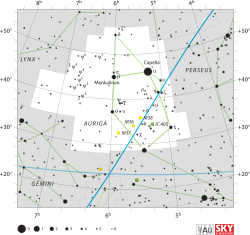Theta Aurigae
| Observation data Epoch J2000 Equinox J2000 |
|
|---|---|
| Constellation | Auriga |
| Right ascension | 05h 59m 43.27012s |
| Declination | +37° 12′ 45.3047″ |
| Apparent magnitude (V) | 2.62 |
| Characteristics | |
| Spectral type | A0pSi + F2-5V |
| U−B color index | -0.18 |
| B−V color index | -0.08 |
| R−I color index | -0.06 |
| Variable type | α2 CVn |
| Astrometry | |
| Radial velocity (Rv) | +29.5 km/s |
| Proper motion (μ) |
RA: +43.63 mas/yr Dec.: -73.79 mas/yr |
| Parallax (π) | 19.70 ± 0.16 mas |
| Distance | 166 ± 1 ly (50.8 ± 0.4 pc) |
| Absolute magnitude (MV) | –1.05 |
| Details | |
| Mass | 3.38 ± 0.08 M☉ |
| Radius | 5.1 ± 0.4 R☉ |
| Luminosity | 263 L☉ |
| Surface gravity (log g) | 3.6 ± 0.05 cgs |
| Temperature | 10,400 ± 300 K |
| Rotation | 3.6187 days |
| Rotational velocity (v sin i) | 55 km/s |
| Other designations | |
| Database references | |
| SIMBAD | data |
Theta Aurigae (θ Aur, θ Aurigae) is a binary star in the constellation Auriga. Based upon parallax measurements, the distance to this star is about 166 light-years (51 parsecs).
The primary component is a large star with more than three times the mass of the Sun and over five times the Sun's radius. It is radiating 263 times the Sun's luminosity from its outer atmosphere at an effective temperature of 10,400 K, giving it the white hue of an A-type star. The star has a stellar classification of A0pSi, with the 'pSi' suffix indicating it is a chemically peculiar star with an abnormal abundance of silicon.
The primary is classified an Alpha2 Canum Venaticorum type variable star and has a surface magnetic field of about 1 kG. Its projected rotational velocity is 55 km s−1, with the star completing a rotation in only 3.6 days. The axis of rotation is inclined by an angle of 51◦ ± 6 to the line of sight from the Earth.
There is a +7.2 magnitude companion, 4.5 magnitudes fainter than the primary, located at an angular separation of 3.91 arcseconds along a position angle of 304.9° as of 2002. This is an F-type main sequence star with a stellar classification in the range F2-5 V. The mean combined apparent magnitude of the system is +2.65 but the variation of the primary causes the system's brightness ranges from magnitude +2.62 to +2.70 with a period of 1.37 days. The system is an X-ray source with a luminosity of 9.49 × 1026 erg s−1.
...
Wikipedia

